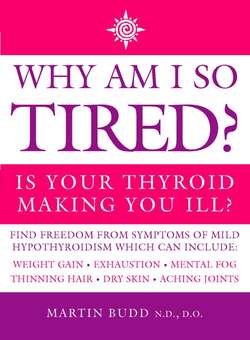Читать книгу Why Am I So Tired?: Is your thyroid making you ill? - Литагент HarperCollins USD, Martin Budd N.D. D.O. - Страница 12
Measuring Your Fatigue
ОглавлениеFor a variety of reasons, fatigue is difficult to recognize, measure and treat. Perhaps the main cause of this difficulty is the nature of the symptom. Fatigue is essentially a subjective symptom. Subjective meaning, ‘due to internal causes and discoverable by oneself alone’. It is a symptom that can be easily masked, you can put on make-up or feign jollity. Therefore, unlike many other symptoms, your fatigue is not always obvious to other people.
Measuring fatigue is another challenge. There are very few health problems that cause a predictable level of fatigue. One immediately thinks of anaemia, the exhaustion of terminal illness or chronic insomnia. Yet I have known patients who were seriously ill with cancer, yet were able to draw on diminishing reserves and present a deceptively normal, even lively demeanour. Our level of fatigue can vary almost from hour to hour, for many factors influence our energy levels. These factors include our blood sugar status, our mood, current and past stress, infection, occupation, how we sleep and for women, the monthly pattern determined by the female hormones. Not forgetting the 30 to 40 illnesses that feature fatigue as a major, predictable symptom. Our state of mind often influences our apparent state of fatigue. How often do we experience an energy surge when receiving good news or meeting a friend or partner?
So as I have said, fatigue is not easy to recognize or to measure in ourselves or in others. Our level of health and any symptoms experienced are unique to each of us. However, in order to tell if you may be fatigued, you can start by asking yourself three simple questions:
1 How do you know you are tired?
2 Do you remember a time in the past when you were not tired?
3 Have you compared your energy levels with colleagues, friends or family members?
The answer to the first question usually leads on to the other two questions. This is because our assessment of how tired we are is usually based on comparison with how we have felt in the past, or comparisons with those who we know and regularly meet.
Typical answers you might reply include:
I know I am much more tired than I was six months ago’
I am always the first in our group to want to go home or go to bed’
More often than not, if you suffer with chronic or long-term fatigue you may have forgotten what it is like to feel normal. You have been tired for so long that you have no memory of better, more vital times. This lack of awareness of the severity of your problem presents a challenge to a practitioner, simply because you can only compare your state of health with friends and family around you. You have therefore lost the potentially more reliable and accurate comparison based on how you yourself once felt.
Consequently, when attempting to assess your fatigue levels, you will find it of great value to talk to your partner or a close relative. Not surprisingly fatigue can influence our mood, our lifestyle and our activities. It is often those close to us who notice changes in our behaviour.
Fatigue can also influence how we look. A loss of sparkle in the eyes, grey outlines beneath the eyes and a postural slump, are all give-away clues to chronic fatigue.
Laboratory Measurements for Fatigue
Health practitioners use laboratory tests to measure if you are fatigued. This is an essential first step to recovery (see chapter nine).
I am quite frequently consulted by fatigued patients who have been offered a diagnosis of chronic fatigue syndrome, fibromyalgia or depression, yet without the evidence of blood and other laboratory tests. I believe it is wise to eliminate the obvious reasons for fatigue before worrying about more obscure illnesses. Certainly late-onset diabetes, pernicious anaemia and nutritional deficiencies need to be considered in elderly patients. Likewise iron deficient anaemia, hypoglycaemia and the effects of stress need to be investigated in young and middle-aged patients.
Tests a doctor or practitioner may offer you can include:
* An assessment of blood fats, kidney, gall bladder and liver function, proteins and blood glucose.
* A haematology profile. This test measures the red and white cells in the blood, assesses iron transport, inflammation, and the clotting factor. A differential count of the white cells also offers information on the immune system.
* A mineral profile. This involves your practitioner taking a sample of hair, blood, sweat or urine.
* A full thyroid profile is also requested to assess if you may be tired.
* A temperature check.
* A six-hour glucose tolerance test may also be needed.
* A red cell essential fatty acid profile may be of value. This measures the blood levels of the omega 3 and 6 series and other fatty acids.
* Occasionally, where indicated, a urine amino acid investigation may be requested.
One needs to be selective when requesting tests. There are over one thousand tests in current use, so it is important for the practitioner to tailor the tests to the patient. If this is not done a lot of money, time, and perhaps patient rapport can be wasted or lost. My procedure for testing for fatigue is described in chapter 11.
